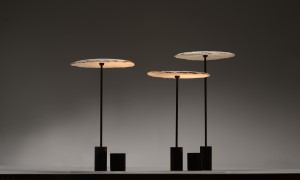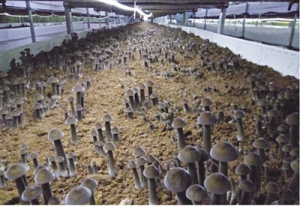
Mushroom Matter
Welcome on our platform. Why MUSHROOM MATTER? Because mushrooms play an important role in our lives as well in business. Our goal is to bring the world the very latest mushroom news with the upmost care to support the positioning of our beloved Mushroom.
Shiitake mushroom garden breeds great prosperity
Mycelium lights
NirMeiri Studio
Founded in 2010 by designer Nir Meiri, Nir Meiri Design Studio offers an out of the ordinary approach to everyday objects.
Carefully selected materials are shaped into clean-cut forms, creating innovative products that play on the tension between the domesticated and the untamed.
Amazing to see how Nir Meiri has achieved to create beautiful lights of Mycelium and Metal and in the shape of our beloved mushroom as well!
This project is a result of an ongoing material research in mycelium -the vegetative part of the fungus -resulting in the design of table lamps collection. Mushrooms or fungi are truly wondrous organisms with significant untapped potential. Mycelium consumes organic and synthetic waste to grow into desired shapes and different types of waste alter its properties. This could have highly significant implications for ridding our planet from the mountains and islands of synthetic waste.
When lit, the light project on the mycelium from below and glows back as soft natural light.
Size: Height 30 / 35 / 40 cm, Diameter 30 cm

The inspiration for this design comes from the fungi itself, resulting in 'a little garden of lights' imitating the shapes of mushrooms growing in the wild.

This project is a collaboration between Nir Meiri Studio and BIOHM- a London based startup working on developing sustainable solutions for the built environment.
The mycelium lights collection has been launched during London Design festival 2018 in 2 different locations:
The first was an exhibition at 'Sustainable Bankside' as part of a show gathering selected sustainable companies to showcase cutting edge designs and ideas. The second exhibition was at 'Open Cell' as part of a curated showcalled 'BIODESIGN -HERE NOW'.
For more information or to view Nir Meirifull product portfolio, please visit www.nirmeiri.com.
Recipe: Honey-sauce King oyster mushrooms
Oudemansiella raphanipes farming boosts poverty removal while promoting bright annual output value
Now it is the good time for mushroom cropping in China, but which is the most profitable variety?
Mushroom Valley is going high in 2019!
Source: Press release Mushroom Valley
Home base Mushroom Valley opened by mayor Kees van Rooij van Meierijstad
Mushroom Valley has appointed Kees van Rooij of Meijerijstad as ambassador on the 21st. of January during their first partner meeting. Purpose of this meeting was also the official opening of the own Box in Box within Brightlands Campus Greenport Venlo and presenting the 2019 plans. Key in this meeting was the culinary experience tour through the home base, Brightlands Campus Greenport Venlo.
Mushroom Valley is established in 2017 with the ambition to empower the international position of the dutch mushroom sector. Mushroom Valley is now doing this together with about thirty partners and more than ten supporters.
Mushroom Valley is going high
"The plans of Mushroom Valley for 2019 are high!" said project leader Jan Janssen last Monday. "An example is the project 'Do you also become so high in mushrooms' that need to enable the enthusiasm of students to go for a career in the mushroom sector. This gives substance to the demand from partners for manpower. A highlight in this context are the Mushroom Days that are being held in 's-Hertogenbosch from 22 to 24 May 2019. "Mushroom Valley is organizing a program for students on the last day of this international mushroom conference. "In addition, our trainee Kevin van Berlo is working hard on realizing 'The mushroom farm of the future'. Within this farm, not only production, but especially innovation, education and connection are key, " says Janssen.
The power of collaboration
To give body to these ambitious plans for 2019, collaboration is key. That is why, just as during the National Mushrooms Day last year, the link was made with the food region of Northeast Brabant. Mayor Kees van Rooij of Meierijstad was allowed to officially open the new home of Mushroom Valley and reveal the 'Mushroom Valley graffiti wall' made by Fish. Van Rooij was then appointed Ambassador of Mushroom Valley by Jan Hulsen, chairman of Mushroom Valley. Because of his dedication prior to the founding of Mushroom Valley, but especially for the connecting role he can and wants to fill between Mushroom Valley and the Northeast Brabant region, which includes AgriFood Capital.
Meet
The leading thread during the partner meeting was the culinary experience tour through the home base, Brightlands Campus Greenport Venlo.
Enjoying delicious appetizers, of course with mushrooms as leading role, guests were introduced to Brightlands cuisine, Kokkerelli, Brightlabs, Bio Treat Center, Compas Agro, Bright 5, MiFood and Bleu Engineering. Mushroom Valley has established itself in the Brightlands Campus Greenport Venlo, which is stationed at Villa Flora. Mushroom Valley shares six box-in-boxes with BVB Euroveen, Brightlabs, Compas Agro, Kipster and Rabobank. Within Brightlands Campus Greenport Venlo innovators from the corporate world, science and education work together on innovations in the area of healthy food, plant breeding, cultivation and alternative raw materials and food sources. Meeting and connecting is central to Brightlands Campus Greenport Venlo, which offers opportunities for both Mushroom Valley and its partners and supporters.
For questions related to this press release, please contact:
Projectlead Jan Janssen
T: 06 53842161
E: This email address is being protected from spambots. You need JavaScript enabled to view it.
Or
Communication Mushroom Valley
Renee Janssen
T: 077 707 4212
E: This email address is being protected from spambots. You need JavaScript enabled to view it.
New name for Dalsem Mushroom Projects
Dalsem Mushroom Projects changes its name into Dutch Mushroom Projects, short DMP.
The name change is part of a bigger plan to reposition the company in the changing mushroom market. As before DMP has a global business approach and a strong focus to turn-key projects. High quality products and services will remain our key drivers for your success. Therefore the change will have no impact on our worldwide customers. The name change will be effective immediately. The entity will remain unchanged. This means that all contracts and agreements between Dalsem Mushroom Projects and their partners will remain valid. We look forward to your long lasting cooperation.
Source: Dutch Mushroom




























